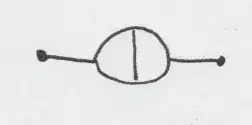The following diagram is given in Srednicki pg62 figure 9.7:
Srednicki gives this diagram a symmetry factor of $S=2^2=4$. But using a method which seems to work on every other diagram I get $S=2$ (the method is given below). Am I missing a subtly here or is the symmetry factor given in the book wrong?
My Method
We split each of the vertices into 3 and count the number of ways we can draw each line between two vertices (as shown below):
The number in front of the brackets gives the number of ways whilst the number in brackets gives the order which I chose them. On top of this we have a factor of $^4C_2 \times 2$ for swapping the $4$ vertices (taking into account that two vertices are identical). This thus gives us a symmetry factor of: $$S^{-1}=\frac{3\times 3\times 6 \times 6\times 2 \times 2 \times 1}{(3!)^4 \times 4!} \times{^4C_2}\times 2$$ $$=\frac{3\times 3\times 6 \times 6\times 2 \times 2 \times 1}{(3!)^4 \times 4!} \frac{4!}{2!2!}\times 2$$ $$=1/2$$ Thus $S=2$
